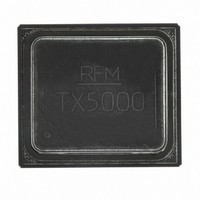TX5000 RFM, TX5000 Datasheet - Page 5

TX5000
Manufacturer Part Number
TX5000
Description
ASH TX 115.2 KBPS 433.92 MHZ
Manufacturer
RFM
Series
TXr
Datasheet
1.TX5000.pdf
(6 pages)
Specifications of TX5000
Frequency
433.92MHz
Applications
General Data Transfer
Modulation Or Protocol
ASK, OOK
Data Rate - Maximum
115.2kbps
Power - Output
0dBm
Current - Transmitting
7.5mA
Data Interface
PCB, Surface Mount
Antenna Connector
PCB, Surface Mount
Voltage - Supply
2.2 V ~ 3.7 V
Operating Temperature
-40°C ~ 85°C
Package / Case
SM-20L
Number Of Receivers
1
Number Of Transmitters
1
Wireless Frequency
433.92 MHz
Operating Supply Voltage
3.3 V
Maximum Operating Temperature
+ 85 C
Mounting Style
SMD/SMT
Maximum Data Rate
115.2 Kbps
Minimum Operating Temperature
- 40 C
Modulation
OOK/ASK
Lead Free Status / RoHS Status
Lead free by exemption / RoHS compliant by exemption
Features
-
Memory Size
-
Lead Free Status / Rohs Status
Lead free / RoHS Compliant
Other names
583-1096-2
www.RFM.com
©2008 by RF Monolithics, Inc.
Pin
10
12
13
14
15
16
17
18
19
20
11
1
2
3
4
5
6
7
8
9
CNTRL1
CNTRL0
TXMOD
E-mail: info@rfm.com
Name
GND1
GND2
GND3
VCC1
VCC2
RFIO
NC
NC
NC
NC
NC
NC
NC
NC
NC
NC
NC
GND1 is the RF ground pin. GND2 and GND3 should be connected to GND1 by short, low-inductance traces.
VCC1 is the positive supply voltage pin for the transmitter output amplifier and the transmitter base-band circuitry. VCC1 is
usually connected to the positive supply through a ferrite RF decoupling bead which is bypassed by an RF capacitor on the
supply side. See the description of VCC2 (Pin 16) for additional information.
No connection. Printed circuit board pad may be grounded or floating.
No connection. Printed circuit board pad may be grounded or floating.
No connection. Printed circuit board pad may be grounded or floating.
No connection. Printed circuit board pad may be grounded or floating.
No connection. Printed circuit board pad may be grounded or floating.
The transmitter RF output voltage is proportional to the input current to this pin. A series resistor is used to adjust the peak
transmitter output voltage. 0 dBm of output power requires 250 µA of input current. In the ASK mode, minimum output power
occurs when the modulation driver sinks about 10 µA of current from this pin. In the OOK mode, input signals less than 220
mV completely turn the transmitter oscillator off. Internally, this pin appears to be a diode in series with a small resistor. Peak
transmitter output power P
A ±5% resistor value is recommended. In the OOK mode, this pin is usually driven with a logic-level data input (unshaped
data pulses). OOK modulation is practical for data pulses of 200 µs or longer. In the ASK mode, this pin accepts analog mod-
ulation (shaped or unshaped data pulses). ASK modulation is practical for data pulses 8.7 µs or longer. This pin must be low
in the power-down (sleep) mode. Please refer to the ASH Transceiver Designer’s Guide for additional information on modula-
tion techniques.
No connection. Printed circuit board pad may be grounded or floating.
GND2 is an IC ground pin. It should be connected to GND1 by a short, low inductance trace.
No connection. Printed circuit board pad may be grounded or floating.
No connection. Printed circuit board pad may be grounded or floating.
No connection. Printed circuit board pad may be grounded or floating.
No connection. Printed circuit board pad may be grounded or floating.
No connection. Printed circuit board pad may be grounded or floating.
VCC2 is the positive supply voltage pin for the transmitter oscillator. Pin 16 must be bypassed with an RF capacitor, and must
also be bypassed with a 1 to 10 µF tantalum or electrolytic capacitor. Power supply voltage ripple should be limited to 10 mV
peak-to-peak. See the ASH Transceiver Designer’s Guide for additional information.
CNTRL1 and CNTRL0 select the transmit modes. CNTRL1 high and CNTRL0 low place the unit in the ASK transmit mode.
CNTRL1 low and CNTRL0 high place the unit in the OOK transmit mode. CNTRL1 and CNTRL0 both low place the unit in
the power-down (sleep) mode. CNTRL1 is a high-impedance input (CMOS compatible). An input voltage of 0 to 300 mV is
interpreted as a logic low. An input voltage of Vcc - 300 mV or greater is interpreted as a logic high. An input voltage greater
than Vcc + 200 mV should not be applied to this pin. A logic high requires a maximum source current of 40 µA. A logic low
requires a maximum sink current of 25 µA (1 µA in sleep mode). This pin must be held at a logic level; it cannot be left uncon-
nected.
CNTRL0 is used with CNTRL1 to control the operating modes of the transmitter. See the description of CNTRL1 for more
information.
GND3 is an IC ground pin. It should be connected to GND1 by a short, low inductance trace.
RFIO is the transmitter RF output pin. This pin is connected directly to the SAW filter transducer. Antennas presenting an
impedance in the range of 35 to 72 ohms resistive can be satisfactorily matched to this pin with a series matching coil and a
shunt matching/ESD protection coil. Other antenna impedances can be matched using two or three components. For some
impedances, two inductors and a capacitor will be required. A DC path from RFIO to ground is required for ESD protection.
P
O
= 16*(I
TXM
)
2
, where P
O
for a 3 Vdc supply voltage is approximately:
O
is in mW, and the peak modulation current I
Description
TXM
is in mA
TX5000 - 4/3/08
Page 5 of 6













